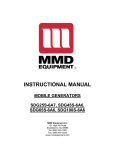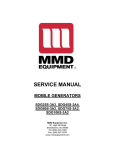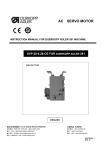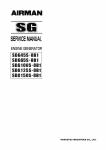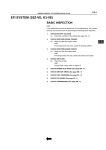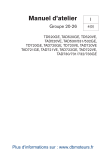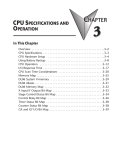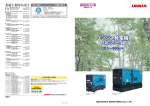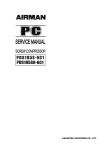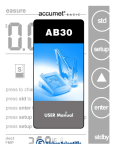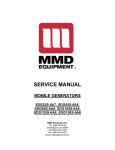Download MMD Equipment SDG150S-6A6 Unit installation
Transcript
Preface ◆ This manual explains and illustrates proper handling of the unit, method of daily inspection and maintenance to enhance the performance of AIRMAN’s generators. ◆ In order to use a machine safely, people with sufficient knowledge and sufficient technology need to deal with it. ◆ Before operating the unit, read the manual carefully, fully understand its operation and maintenance requirement. Maintain “SAFETY OPERATION AND PROPER MAINTENANCE OF THE UNIT”. Be sure to follow safety warnings and cautions given in the manual. Unsafe operation could cause serious injury or death. ◆ For details of handling, maintenance and safety of the engine, see the Engine Operation Manual. ◆ Keep the manual available at all times for the operator or safety supervisor. ◆ If the manual is lost or damaged, place an order with your dealer for another copy. ◆ Be sure that the manual is included with the unit when it is handed over to another user. ◆ There may be some inconsistency in detail between the manual and the actual machine due to improvements of the machine. Ask your dealer if you have any questions or problems. ◆ If you have any questions about the unit, please inform us the model and serial number. A plate stamped with the model and serial number is attached to side of the unit. A040491 Table of Contents 1. Safety ....................................................................................................................................................... 1.1 Caution before Operation ................................................................................................................ 1.2 Caution during Operation ................................................................................................................ 1.3 Caution during Inspection and Maintenance ................................................................................... 1.4 Safety Warning Labels .................................................................................................................... 1-1 1-2 1-4 1-6 1-8 2. Part Names .............................................................................................................................................. 2-1 2.1 Unit Appearance and Part Names ................................................................................................... 2-1 2.2 Internal Components....................................................................................................................... 2-2 3. Installation ............................................................................................................................................... 3.1 Transporting Unit ........................................................................................................................... 3.2 Place and Conditions of Unit Installation ................................................................................... 3.3 Connecting load ................................................................................................................................ 3.4 Selecting Cable ............................................................................................................................... 3.5 Grounding Method ............................................................................................................................ 3.6 Selector Valve of Fuel Pipe.......................................................................................................... 3-1 3-1 3-2 3-5 3-9 3-10 3-11 4. Operation ................................................................................................................................................. 4.1 Instrument panel ............................................................................................................................ 4.2 Protection device ........................................................................................................................... 4.3 Check before Starting the Unit .................................................................................................... 4.4 Unit Operation ................................................................................................................................ 4.5 Stopping Procedures..................................................................................................................... 4.6 Emergency Stop .............................................................................................................................. 4.7 Air Bleeding...................................................................................................................................... 4-1 4-1 4-3 4-7 4-9 4-12 4-13 4-13 5. Periodic Inspection/Maintenance .......................................................................................................... 5.1 Important items as Periodic and Maintenance or after Maintenance .............................................. 5.2 Daily Inspection and keeping Operation Log ................................................................................... 5.3 Periodic Inspection List ................................................................................................................... 5.4 Periodic Replacement of Parts ......................................................................................................... 5.5 Maintenance ..................................................................................................................................... 5-1 5-1 5-2 5-3 5-4 5-5 6. Maintenance/Adjustment ....................................................................................................................... 6-1 6.1 Maintenance of Battery ..................................................................................................................... 6-1 6.2 Troubleshooting ................................................................................................................................ 6-3 7. Storage of the Unit ................................................................................................................................. 7-1 7.1 Preparation for Long-term Storage ................................................................................................. 7-1 8. Specifications ......................................................................................................................................... 8-1 8.1 Specifications.................................................................................................................................... 8-1 8.2 Outline drawing .............................................................................................................................. 8-3 9. Wiring Diagram ....................................................................................................................................... 9-1 9.1 Generator Wiring Diagram ................................................................................................................ . 9-1 9.2 Engine Wiring Diagram ..................................................................................................................... . 9-3 1 1.Safety This operation manual explains and illustrates general requirements for safety and cautions for safety. Please read these safety requirements carefully and fully understand the contents before starting the machine. For your better recognition, according to the degree of potential danger harmful to a human body, safety messages are classified into three hierarchical categories, namely, , , and with a caution symbol −attached to each message. When one of these messages is found, please take preventive measures for safety to carry out “SAFETY OPERATION AND PROPER MAINTENANCE OF THE UNIT ”. DANGER indicates an imminently hazardous situation which, if not avoided, will result in death or serious injury. This signal word is to be limited to the most extreme situations. WARNING indicates a potentially hazardous situation which, if not avoided, could result in death or serious injury. CAUTION indicates a potentially hazardous situation which, if not avoided, may result in minor or moderate injury. It may also be used to alert against unsafe practices. IMPORTANT indicates important caution messages for the performance or durability of the unit, which has no concern to injury or accident of or to a human body. Follow warnings mentioned in this manual. This instruction manual does not describe all safety items. We, therefore, advise you to pay special attention to all items (even though they may not be described in the manual) for your safety. 1-1 1.Safety 1.1 Caution before Operation Follow the safety instructions Read each instruction plate which is displayed in the manual or on the machine carefully, understand its content and follow the indications thereof. Keep the Safety Warning labels clean. When they are damaged or missing, apply new ones. Do not modify the machine without prior approval. The safety may be compromised, functions may be deteriorated, or machine life may be shortened. Never use the machine for the other purposes than power supply. Otherwise, serious accidents may occur. TR0086 Ventilation Exhaust gas from the engine is poisonous, and could cause casualties when it is inhaled. Avoid using the machine in an insufficiently ventilated building or a tunnel. PC002 Handling battery Keep flames away from battery. Battery may generate hydrogen gas and may explode. Battery electrolyte is dilute sulfuric acid. In case of mishandling, it could cause skin burning. Wear protective gloves and safety glasses when handling a battery. Dispose of battery, observing local regulations. D004 TR0093 1-2 1.Safety Safety outfit When handling machine, do not wear; loose clothes clothes with unbuttoned sleeves hanging tie or scarf dangling jewelry Such outfit could be caught in the machine or dragged in the rotating portion of the machine, and could cause a serious injury. TR0084 Maintain both physical and mental health Do not operate the machine when you are tired or drunk or under the influence of drugs. Otherwise, a hasty conclusion or careless handling may cause unexpected injury or accident. Manage your physical and mental health and be cautious in handling the machine. Protection equipments Please wear protection implements, such as a helmet, protection glasses, earplugs, safety shoes, a glove, and a protection-against-dust mask, according to the contents of work for safety. TR0085 Safety fittings Have first-aid boxes and fire-extinguishers near the unit ready for emergency situations such as injuries and a fire. It is advisable to have a list of phone numbers of doctors, ambulance and the fire department available in case of emergency. TR0096 Safety around the machine Such things as unnecessary equipment and tools, cables, hoods, canvas sheets and pieces of wood which are a hindrance to the job, have to be cleared and removed. This is because operators and personnel nearby may stumble on them and may be injured. 1-3 1.Safety 1.2 Caution during Operation Never touch the output terminals and interior of control board Never touch the output terminals during operation. Notice that the voltage of several hundreds volt is applied to the output terminal. When removing or connecting a connecting cable for changing load, be sure to switch OFF the circuit breaker, remove the starter key from the starter switch, then carry out a work. The operator must keep the key during operation. Neglecting the cautions mentioned above, and a third party starting the machine during operation may cause serious accidents such as electric shock. Never touch the interior of the control panel during operation. Notice that the voltage of several hundreds volt is applied to the interior of the control board. When checking or operating the interior of control panel, be sure to stop the machine, remove the starter key from the starter switch, then carry out a work. The operator must keep the key during operation. H990208 Hands off from rotating parts and belts Keep hands off from the rotating portion or belts while running. It could cause serious injuries if hands should be caught in. TR0304 Do not remove radiator cap during operation Do not, under any circumstance, open the radiator cap while running or immediately after stopping operation. Otherwise high temperature steam jets out and this could cause scalding. H990432 1-4 1.Safety Do not touch hot parts Never work nearby hot portions of the machine while it is running. Do not touch hot portions of the machine while inspecting the machine when running. Such parts as engine, exhaust manifold, exhaust pipe, muffler, and radiator are especially hot, so never touch those parts, because it could cause scalding. Coolant water and engine oil are also very hot and dangerous to touch. Avoid checking or refilling them while the unit is running. H990432 Fire prevention Do not, under any circumstance, bring lit cigarettes or matches near such oils as diesel fuel oil, and engine oil, etc. They are extremely flammable and dangerous, so be careful when handling. Refilling oils should be done in an outdoor well-ventilated place. Refuel after stopping the engine, and never leave the fuel nearby the machine. Do not spill. It may cause a fire. When it is spilt, wipe it up completely. Such parts as muffler and exhaust pipe can be extremely hot. Remove twigs, dried leaves, dried grass and waste paper, etc. from the exhaust outlet of the muffler. Keep a fire extinguisher available by the machine in case of unexpected fire. D004 H990433 Draining during operation prohibited Do not, under any circumstance, open the portions below during operation. Coolant drain valve and plug Engine oil drain plug PK0028 Unbalance of overload and load Reduce the load when the circuit breaker actuates frequently during operation. When a single-load is used, check the current of each phase, and adjust the load so that each load value should be balanced. If the above procedure is neglected during operation, the generator could be burned or it could cause a fire. If the machine is operated with the frequency lower than the rated frequency, it could cause the generator or load motor to be burned. 1-5 1.Safety 1.3 Cautions during Inspection and Maintenance Hang a “Now Checking and under Maintenance” tag Before starting inspection, switch off the circuit breaker of this machine, remove the starter key from the starter switch, and then hang a “Now Checking and under Maintenance” tag where it can be easily seen. The checker must keep the key during checking and maintenance. Remove the negative (–) side cable from the battery. If the above procedure is neglected, and another person starts operating the machine during check or maintenance, it could cause serious injury. SY001 Adjusting tension of fan belt Be sure to stop the engine and remove the starter key whenever the tension of the fan belt is to be adjusted. If the machine is running, it might catch the operator’s hand into the fan belts, and this could cause a serious injury. TR0304 Hands off from cooling fan Be sure to stop the engine and remove the starter key whenever check or maintenance work is carried out near the cooling fan. If the cooling fan is rotating, it may catch the operator or part of his body into the fan, and it could cause a serious injury. W009 Cleaning by air-blow When cleaning dust accumulated in such devices as the air-filter, etc., by blowing compressed air, wear safety glasses, etc. to protect your eyes. W003 Lighting apparatus It is recommended to use a lamp with safety guard fitted where the site is dark. Operating the machine gropingly or by relying on one’s intuition could cause unexpected accidents. Any lamps without safety guard are not recommended since they can be broken and they could ignite flammables such as fuel, etc. 1-6 TR0206 1.Safety Taking off the radiator cap Be sure to stop the machine first and then loosen the radiator cap slowly, after the coolant water is sufficiently cooled and the inner pressure is released. If this procedure is neglected, its inner pressure can blow off the cap,and steam jetting out of the radiator could result in causing scalding. Follow these procedures under all circumstances. H990432 Opening coolant water drain valve Be sure to stop the engine, and let the coolant water sufficiently cool down before draining it. If the drain valve is opened before the coolant water is cooled enough, hot water could jet out, and it could cause scalding. H990432 Refilling or draining of engine oil After stopping the engine, wait 10 to 20 minutes until the engine oil cools off. Then check the level of the engine oil, or refill or drain the oil. During operation or immediately after the engine stops, its oil is extremely hot and pressurized, so it may jet out when the cap is loosened. Be careful not to scald yourself from it. H990432 Cleaning the unit When washing the machine, cover the control panel, generator and its electric parts to prevent them from being exposed to splashing water and avoid possible decrease in electrical insulation or other troubles to the machine. Disposal of waste liquid, etc. Waste liquid from the machine contains harmful material. Do not discharge it onto the ground or into the river, lake or sea. Such material will pollute the environment. Be sure to use a container to hold the waste liquid from the machine. Be sure to follow the designated regulations when disposing of oil, fuel, coolant (antifreeze), filter, battery or other harmful materials. 1-7 2. Part Names 2.2 Internal Components 1 2 17 16 3 4 15 14 5 6 13 12 11 SDG125S-6A6 1. Control panel 7 10 9 8 A050157-1 9. Radiator 2. Air filter 10. Intercooler 3. Engine 11. Fuel filter 4. Reserve tank 12. Engine oil filter 5. Engine oil filler port 13. Fuel pump 6. Engine oil level gauge 14. Fuel pre- filter 7. Exhaust muffler 15. Battery ※ 8. Fuel tank 16. Output terminals 17. Generator Instrument 15 marked “※” are provided on the other side. (opposite side of maintenance). 2-2 2. Part Names 1 18 17 2 16 3 4 15 14 5 6 13 12 11 7 10 9 SDG150S-6A6 8 A050585 9. Radiator 1. Control panel 2. Air filter 10. Intercooler 3. Engine 11. Fuel filter 4. Reserve tank 12. Engine oil filter 5. Engine oil filler port 13. Fuel pump 6. Engine oil level gauge 14. Fuel pre- filter 7. Exhaust muffler 15. Battery ※ 8. Fuel tank 16. Output terminals 17. Generator 18. Voltage selector switch Instrument 15 marked “※” are provided on the other side. (opposite side of maintenance). 2-3 3. Installation 3.3.3 The Maximum Combined Simultaneous Power Consumption Never exceed the maximum combined simultaneous power consumption. The following chart shows the maximum power available from the 120V-20A GFCI receptacles during simultaneous consumption (main terminals and receptacles) for both single or three phase settings. Values shown in the left column give the maximum current available at the 120V-20A GFCI receptacles compared to the value of the simultaneous current consumption from the main terminals. SDG125S SDG150S Single Phase 120V-20A GFCI Rcept. Three Phase 240/480V Single Phase 240/120V Three Phase 240/480V Single Phase 240/120V kW 0.0 1.2 2.4 3.6 4.8 kVA 125 121 117 113 108 kW 72.0 70.8 69.6 68.4 67.2 kVA 150 146 142 138 133 kW 87.0 85.8 84.6 83.4 82.2 3-8 3. Installation 3.4 Selecting Cable Select a cable with sufficient diameter by considering the permissible current on the cable and the distance from the generator to the load. If the current flowing to the load exceeds the permissible current of the cable, resultant overheating may burn the cable. Similarly, if the cable is too small in thickness to the length, the input voltage to the load will fall to cause the load input power to drop, as a result, the performance of the machine cannot be displayed. Working Current I (A) Cable Thickness A (mm2) Cable Length L(m) A040657 Simplified three-phase three-wire formula to seek voltage drop from cable length and working current. Select such a cable length and thickness so that the voltage drop will remain less than 5%. Output system Voltage drop Three-phase 3-wire Type e = 30.8×L×I 1,000×A Three-phase 4-wire Type e’= 17.8×L×I 1,000×A e :Voltage drop(V) e’:Voltage drop between an outside line or one line of each phase, and a neutral line (V) A :Cable thickness (mm2) L :Cable length (m) I :Working current (A) The following tables show the relations between the cabtyre cable length and the cable thickness (nominal cross-sectional area) suited to the working current. (Based on the condition that working voltage is 200 V, with voltage drop of 10V.) Single-Conductor Cabtyre Cable Length Unit:mm2 50m 75m 100m 125m 150m 200m 50A 8 14 22 22 30 38 100A 22 30 38 50 50 60 150A 38 38 50 60 80 100 Current Three-Conductor Cabtyre Cable Length Unit:mm2 50m 75m 100m 125m 150m 200m 50A 14 14 22 22 30 38 100A 38 38 38 50 50 60 150A 22×2 22×2 38×2 38×2 38×2 50×2 Current 3-9 4. Operation 4.1 Instrument panel 1 2 3 4 5 6 7 8 9 10 11 12 13 14 15 16 24 23 22 21 20 19 18 17 SDG125S-6A6 1. Panel light switch 13. Diagnostic lamp 2. Frequency meter 14. Diagnostic button 3. Voltmeter 15. Selector switch 4. Panel light 16. Starter switch 5. Ammeter 17. Engine oil pressure gauge 6. Fuel gauge 18. Coolant temperature gauge 7. Tachometer with hourmeter 19. Ammeter for battery charge 8. Engine oil pressure drop warning lamp 20. Speed control knob 9. Coolant temp. rise warning lamp 21. Ammeter change-over switch 10. Over crank warning lamp 22. Voltage regulator 11. Glow lamp 23. Voltage selector switch 12. Air filter clogging flickers warning lamp 24. Main circuit breaker 4-1 A050125 4. Operation 1 2 3 4 5 6 7 8 9 10 11 12 13 14 15 16 23 22 21 20 19 18 17 SDG150S-6A6 A050554 1. Panel light switch 13. Diagnostic lamp 2. Frequency meter 14. Diagnostic button 3. Voltmeter 15. Selector switch 4. Panel light 16. Starter switch 5. Ammeter 17. Engine oil pressure gauge 6. Fuel gauge 18. Coolant temperature gauge 7. Tachometer with hourmeter 19. Ammeter for battery charge 8. Engine oil pressure drop warning lamp 20. Speed control knob 9. Coolant temp. rise warning lamp 21. Ammeter change-over switch 10. Over crank warning lamp 22. Voltage regulator 11. Glow lamp 23. Main circuit breaker 12. Air filter clogging flickers warning lamp ※ The voltage selector switch is provided inside the unit. (See page 2-3, No.18) 4-2 4. Operation 4.2 Protection device For prevention of troubles during operation, this machine is provided with various protection devices. If the engine should shut down or circuit-breaker should trip owing to functions of the protection devices, make sure to check and remove such cause of trouble. Then start operation again. 4.2.1 Warning and Emergency Display lamp Warning and Emergency Display When the warning lamp glows, stop the machine immediately and take appropriate measures to recover the situation. Item Engine oil pressure Coolant temperature Trouble Measures This lamp goes on when engine oil pressure drops during operation and emergency stop is actuated. This lamp lights off after engine stops. Operating pressure: lower than 30psi (0.2MPa) This lamp goes on when coolant temp. rises. If coolant temp. rises more, engine takes emergency stop. When coolant temp. drops, this lamp lights off. Temp. of lamp on:230°F(110℃) Temp. of emergency stop:235°F(113℃) Temp. of lamp off:228°F(109℃) Overcrank This lamp goes on when operator fails to start engine, during automatic operation mode. Air filter When air filter gets clogged and differential pressure rises, lamp goes on. Actuating differential pressure : more than 0.9psi(6.2 kPa) Diagnostic lamp This lamp blinks when engine trouble happens. Then, a pattern of lamp signals changes if “DIAGNOSTIC BUTTON” is pushed. The pattern of lamp signals shows what’s kind of trouble happens. Refer to “OPERATOR’S MANUAL”(P37). 4-3 See 6.2 Troubleshooting Monitor 5. Periodic Inspection/Maintenance 5.1 Important Items at Periodic Inspection and Maintenance or after Maintenance The manual shows proper interval for periodic inspection and maintenance under normally operating conditions. Inspection and maintenance should be performed more often under extremely harsh conditions. Hang a“Now Checking and under Maintenance”tag Remove the starter key from the starter switch before starting inspection, and hang up a “Now Checking and under Maintenance” tag where it can be easily seen. The checker must keep the key during checking and maintenance. Remove the negative (-) side cable from the battery. If the above procedure is neglected, and should another person start operating the machine during check or maintenance, it could cause serious injury. Be sure to use appropriate tools for inspection and maintenance work. Inappropriate tools could cause unexpected injury. SY001 Precaution for check and maintenance Be sure to use recommended fuel, oil, grease, or antifreeze. Do not disassemble or adjust engine, compressor or part(s) for which inspection or maintenance is not referred to in this manual. Use genuine parts for replacement. Any breakdown, caused by using unapproved parts or by wrong handling, will be out of the scope of “WARRANTY”. Do not pour water or steam on electrical components. Place a container or a pan underneath the oil port to receiver waste liquid so that such liquid cannot be spilt out on the floor or inside the machine. Be sure that no waste liquid is disposed of on the ground. Such waste on the ground, river or lake will cause serious environmental contamination. Be sure to follow the local regulations. If harmful material such as oil, antifreeze solution or filters are disposed of incorrectly, the responsible person should be punished by the authority. Observe local regulations when disposing of such toxic materials as oil, fuel, coolant (anti-freeze), filters, and battery etc. 5-1 5. Periodic Inspection/Maintenance 5.2 Daily Inspection and Keeping Operation Log Be sure to carry out daily inspection every morning before operation. See Chapter 4 “OPERATION” of the manual for the details of inspection. Pay attention to and carefully observe the following points during daily operation or inspection and maintenance work. If any trouble or abnormality is found, immediately investigate its cause and make repairs. If the cause is unknown or not traceable, or if the trouble involves a part or component not described in the manual, ask your nearest dealer for information. (a) Controls and instruments function properly. (b) Quantity and any leak of water, fuel, and oil or any contamination should be checked. (c) Appearance, abnormal noise or excessive heat should be checked. (d) Loose bolt or nut should be checked. (e) Any damage, wear or shortage of machine components and parts should be checked. (f) Performance of each part or component should be proper. TR0049 Keep the operation log to record constant inspection of each component, so that trouble of the unit can be easily discovered and preventive measures can be taken. It is very useful to record information such as frequency, temperature, current, maintenance items and replenishment of lubricant on a daily maintenance log. 5-2 5. Periodic Inspection/Maintenance 5.3 Periodic Inspection List Such items marked ○ shall be carried out by customers. For the following items or clauses marked ●, contact us directly or our distributors because they require expert technical knowledge on them. ◎Refer to engine operation manual for inspection and maintenance of an engine. (Unit : Hour) Maintenance Generator Check each instrument and warning lamp. Daily 50 250 500 Page Check insulation resistance. Check GFCI receptacles. ○ 5-6 ○ 5-7 (Every monthly) How to check thermal relay. ○ 5-7 Check and Clean Clogging of Air Filter Element. ○ 5-8 ○ Drain fuel tank. 5-13 5-8 ○ Check fuel level. ○ 4-8 Check engine oil level. ○ 4-7 Check coolant level. ○ 4-7 Check looseness in pipe connector terminals and tear in wiring. Check V-belt tension. Change engine oil. 5-9 ○ 4-8 ○ ○ ○ 5-5 ○ 5-6 Check fuel pre-filter drain ○ 5-8 Check battery electrolyte. ○ 5-9 Change engine oil filter. Remarks 4-12 ○ Change Air Filter Element Engine 1,000 (First time) ○ (First time) Check Specific gravity of battery electrolyte. ○ 5-9 Change fuel filter. ○ 5-9 Change fuel pre-filter ○ 5-10 Check engine valve clearance. ● Adjust fuel injection nozzle. ● Check fuel injection timing. ● ○ Change coolant. (Every 2 years) Clean outside of Radiator and Intercooler. Check rubber hose. ○ Clean inside the radiator. ● 5-3 5-11 5-10 ○ In the case of NG, it exchanges. 5-13 Dirt condition cleans. 5. Periodic Inspection/Maintenance 5.4 Periodic Replacement of Parts Use our genuine elements Air filter is a crucial component for the performance and the life of a unit. Use genuine part for replacement. Part number changes upon modification. For replacement of parts, make sure whether the part number is correct or applicable. Part Name Part Number Quantity VOLVO 20405830-9 1 Engine oil filter VOLVO 3831236-9 1 Fuel filter VOLVO 3825133-6 1 Filter insert VOLVO 20430640-1 1 Sealing ring VOLVO 20430641-9 1 Alternator VOLVO 978515-5 1 Fan VOLVO 978750-8 1 Air filter Fuel pre-filter V-belt Filter insert 5-4 5. Periodic Inspection/Maintenance 5.5.14 Change Coolant 1,000 hours or every 2 years Taking off radiator cap Be sure to stop the machine and loosen the radiator cap slowly, after the coolant water is sufficiently cooled and the inner pressure is released, then take the cap off. If this procedure is neglected, the inner pressure can blow off the cap. Steam jetting out of the radiator could result in causing scalding. Follow the procedure under all circumstances. H990432 How to handle LLC(Antifreeze) LLC (Antifreeze) is a toxic material. When a person has drunk LLC (Antifreeze) by accident, make him vomit and make him see a doctor immediately. When a person gets LLC (Antifreeze) in his eyes, wash the eyes with clean running water and make him see a doctor immediately. When LLC (Antifreeze) is stored, put it in a container with an indication saying "LLC (Antifreeze) inside" and seal it up, then Keep it in a place away from children. Beware of flames. Follow the designated regulations to dispose of LLC (Antifreeze). Quality of coolant and antifreeze Use soft water of good quality such as tap water for coolant. When water with dirt, sand, and/or dust contained, or hard water such as well water (ground water) is used, this will cause deposits inside radiator or on cylinder head, and will cause engine overheat due to poor flow of coolant. When the unit is used in a cold region and possible freezing is expected, it is recommended to use LLC (Antifreeze) for the coolant. Adjust mixing ratio of LLC with water according to the temperature. Use LLC within the range of its mixing ratio between 35 and 60%. If LLC in the water exceeds more than 60%, it may decrease its antifreezing effect. Reference of LLC mixing ratio Temperature Mixing ratio −4°F (−20℃) 35% −40°F (−40℃) 55% Follow the designated regulations to dispose of LLC (Antifreeze). 5-11 5. Periodic Inspection/Maintenance (Procedure) ① To drain coolant, remove the radiator cap“1”, then loosen the drain valve“2”. ② Be sure to also unfasten the drain plug“3”on the engine cylinder block for drainage. ③ When the coolant is completely drained out, close each drain valve“2”and drain plug“3”, and supply new coolant from the filler port“4”. ④ After changing the coolant, run the engine under unload operation for 2 to 3 minutes, then stop it. Check the coolant level again and replenish it if necessary. 1 4 2 A050138 3 A050139 5-12 5. Periodic Inspection/Maintenance 5.5.15 Change Air Filter Element Every 1,000 hours Be sure to properly clean air filter element When an element that is clogged or has holes or cracks is used, dust or foreign material will get in the engine. This causes accelerated wear in each sliding part of the engine. Be sure to make daily check and cleaning so that the life of the engine will not be shortened. If the warning lamp for air filter clogging glows, remove the element “1”and replace it after inspection. (See 5.3) In case you attach the cup“2”after element change, please push into a case“3”firmly by hand, and fasten after checking having applied the hook of the handle for cup fixation to the case“3”. 2 1 3 A050136 5.5.16 Check Rubber hose Every 1,000 hours When any crack or wear is found on the hoses, change it even before the scheduled time. Ask your nearest dealer for its replacement. 5-13 6. Maintenance/Adjustment 6.1 Maintenance of Battery Handling battery Keep flames away from battery. Battery may generate hydrogen gas and may explode. Therefore, recharging should be done at a well-ventilated place. Do not spark near the battery nor light a match, nor bring lit cigarette and match close to the battery. Do not check the battery by short-circuiting the positive and negative terminals with a metallic piece. Never operate the machine nor charge the batteries with the battery liquid level being kept lower than the “LOWER” level. Continuing operation at this lower level will cause deterioration of such parts as pole plates etc., and also it may cause explosion as well as reduction of battery life. Add distilled water so that the liquid level may reach the middle level between the “UPPER” and “LOWER” level without any delay. Do not charge the frozen battery. Otherwise it may explode. If the battery is frozen, warm it up until the battery temperature becomes 16°C to 30°C. Battery electrolyte is dilute sulfuric acid. In case of mishandling, it could cause skin burning. Wear protective gloves and safety glasses when handling a battery. When such battery electrolyte contacts your clothes or skin, wash it away with large amount of water immediately. If the battery electrolyte gets into your eyes, wash it away immediately with plenty of water and see a doctor at once, because it is feared that eyesight might be lost. Dispose of battery, observing local regulations. D004 W010 TR0093 Reverse connection prohibited Never reverse the cable connections. − When a booster-cable is unavoidably used or when a set of cables is connected after a battery change, be sure to correctly connect the electric terminals (+) and (–). Reversely-connected cables will cause sparks or damage to components. 6-1 6. Maintenance/Adjustment 6.2 Troubleshooting Should any trouble occur during operation, do not leave it. Investigate the cause and take appropriate measures. Read the manual carefully and fully understand what to do in case of trouble. The better you understand the construction and function of the unit, the faster you can find a problem and solution. This chapter describes the state, cause and countermeasures of important troubles in detail: When “DIAGNOSTIC LAMP” turn on, push “DIAGNOSTIC BUTTON” and check “FAULT CODE”. See “OPERATOR’S MAUAL” and research the cause of trouble. Symptom Starter does not rotate. Low starter revolution speed even when starting. Cause Counter measures (1)Battery malfunction Check Battery →Charge/Change Starter rotates but engine does not start up. (1)Fuel filter clogging (2)Fuel pre-filter clogging (3)No diesel fuel oil (4)Air mixing in fuel pipings Disassemble, clean, and change Disassemble, clean, and change Replenish fuel Bleed air Engine oil pressure drop warning lamp glows. (1)Engine oil shortage (2)Engine oil filter clogging (3)Oil pressure switch malfunction (4)Loosened or disconnected wiring, or connector Replenish fuel Change Change Check/repair Coolant temperature rise warning lamp glows. (1)Radiator clogging (2)Faulty thermostat (3)Faulty coolant temperature switch (4)Shortage of coolant (5)Slip of fan belt (6)Looseness, disconnection of wiring or connectors Clean Change Change Replenish Adjust tension Check/repair Leakage warning (1) Leakage on generator side lamp glows. (2)Leakage on load side (3)Leakage on connecting cable (4)Defective leakage relay Check/repair Check/repair Check/repair Check/repair The warning lamp for air filter clogging flickers. Clean (1) Air filter clogging 6-3 6. Maintenance/Adjustment Symptom Even when operated at a rated speed, no voltage or too low voltage generated. (1) (2) (3) (4) (5) (6) (7) (8) (9) Too high voltage generated when set at the rated frequency (50Hz/60Hz), Voltage will not drop even when the voltage regulator controlling knob is turned. (1) (2) (3) Cause Faulty voltmeter Poor tightening of terminals Broken or short-circuited winding of generator main unit Faulty AVR Faulty silicon rectifier (mounted on generator rotor) Faulty exciter Broken or short-circuited circuit to exciter field winding AVR frequency selection switch is not set to meet the frequency to be operated. Function circuit protector (CP) for AVR protection Loosened or disconnected wiring, or connector to AVR Faulty AVR Broken wire or poor contact of AVR variable resistor Unstable voltage (1) Poor tightening of each terminal generation (2) Faulty AVR (3) Function circuit protector (CP) for AVR protection Counter measures Check/change Check/repair Check/repair Check/change Check/change Check/repair Check/repair Check/select Reset Check/repair Check/change Repair or change Check/repair Check/change Reset Please contact your nearest dealer if you find it difficult to repair by yourselves. Please refer to the engine operation manual for troubles concerning the engine. 6-4 7. Storage of the Unit 7.1 Preparation for Long-term Storage When the unit is to be kept unused in storage for a long time, be sure to follow the preparations below and put the unit in a dry and less dusty place. Put the unit in a temporary cabin if it is stored outside. Avoid leaving the unit outside with a sheet cover directly on the paint for a long time, or this will cause rust to the unit. Perform the following treatments at least once every three months. (Procedure) ① Discharge existing lubricant from the engine oil pan. Pour new lubricant in the engine to clean its inside. After running it for a while, drain it again. ② Spread lubricant on each moving part. ③ Completely charge the battery and disconnect grounding wires. Remove the battery from the unit, if possible, and store it in a dry place. (Charge the battery at least once every month.) ④ Discharge coolant and fuel from the unit. ⑤ Seal air-intake port of engine and other openings like the muffler with a vinyl sheet, packing tape, etc., to prevent moisture and dust from getting in the unit. ⑥ Be sure to repair any trouble and maintain the unit so that it will be ready for the next operation. Stacking up box type machines When stacking up the machines for storage, only two units stacking is acceptable. The mass of the lower machine should be larger than that of the upper one. Select a leveled floor with sufficient strength. Before stacking the machines up, check the machine for deformation of bonnet, looseness or missing of bolts, and other parts. When stacking them, be sure to securely fix them as shown in the figure so that the balanced weight is applied to each squared lumber for preventing a sideslip or a collapse.(Make sure to use 4 pieces of rectangular lumber.) Never operate the machines with stacking conditions. It is very dangerous. Machines stacked could fall down due to sideslip or collapse when an earthquake occurs. Therefore, safety should be sufficiently considered for surroundings of storage places. 7-1 H000028-2 8. Specifications 8.1 Specifications Model SDG125S-6A6 Brushless system Exciting system Armature connection Star with Neutral ZigZag Three Single 80 100 Generator Phase number Power factor % Frequency Hz 60 Rated output kVA 125 72 Rated output kW 100 72 Voltage V 240 480 240/120 Current A 300 150 300 Model VOLVO TAD720GE Type 4-cycle,water-cooled,direct injection,turbo charged,intercooled Number of cylinders Total displacement Rated output Engine Revolution per minute Lubricating oil capacity Coolant capacity (including radiator) 6 L 7.15 kW 142 min-1 1,800 L 20 L 25 Battery Fuel tank capacity 170F51 (12V) L 250 Overall length mm 3,030 Overall width mm 1,180 Overall height mm 1,480 Net dry mass kg 2,180 Operating mass kg 2,420 8-1 8. Specifications Model SDG150S-6A6 Brushless system Exciting system Armature connection Star with Neutral ZigZag Three Single 80 100 Generator Phase number Power factor % Frequency Hz 60 Rated output kVA 150 87 Rated output kW 120 87 Voltage V 240 480 240/120 Current A 361 180 363 Model VOLVO TAD720GE Type 4-cycle,water-cooled,direct injection,turbo charged,intercooled Number of cylinders Total displacement Rated output Engine Revolution per minute Lubricating oil capacity Coolant capacity (including radiator) 6 L 7.15 kW 142 min-1 1,800 L 20 L 25 Battery Fuel tank capacity 170F51 (12V) L 250 Overall length mm 3,030 Overall width mm 1,180 Overall height mm 1,480 Net dry mass kg 2,330 Operating mass kg 2,570 8-2 9. Wiring Diagram SDG150S-6A6 Terminal plate To Battery A.C.Generator To Monitor lamp A050586 9-2 HOKUETSU INDUSTRIES CO., LTD. 12TH FLOOR SHINJUKU SAN-EI BLDG, 22-2 NISHI-SHINJUKU 1-CHOME,SHINJUKU-KU TOKYO 160-0023 JAPAN TEL:TOKYO 813(3348)7281 FAX:TOKYO 813(3348)7289 URL:http//www.airman.co.jp 39600 58921 PRINTED IN JAPAN 2005.11



































































